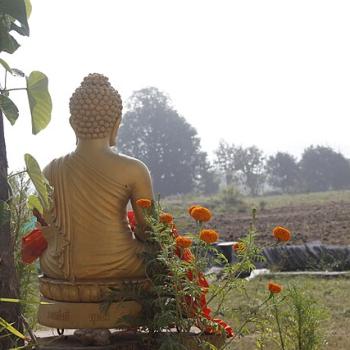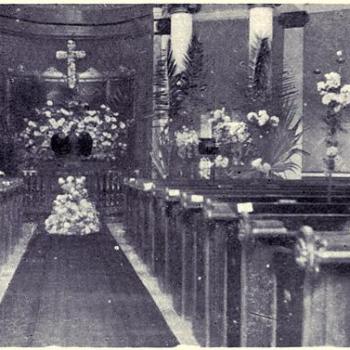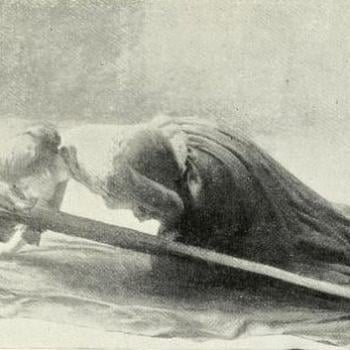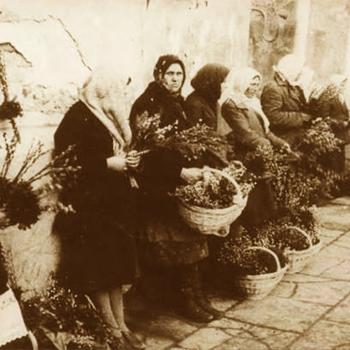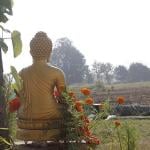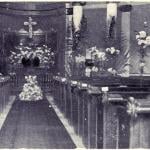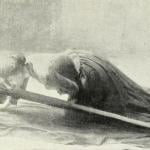THE ROYAL ROAD TO ROMANCE
A Meditation on the Pilgrim Path and an Invitation
27 February 2011
James Ishmael Ford
First Unitarian Church
Providence, Rhode Island
Text
I live my life in widening circles that reach out across the world. I may not complete this last one but I give myself to it. I circle around God, around the primordial tower. I’ve been circling for thousands of years and I still don’t know: am I a falcon, a storm, or a great song?
Ranier Maria Rilke
Richard Halliburton was one of those authors I probably read before I knew how to read. Ours was a household that always had books that spilled off the shelves and were piled up in various places in most every room. Even though we moved a lot, and sometimes moved in a car, books were considered a necessity. Now, whether we had the same copy throughout my childhood, or it was simply something that my mother replaced from time to time, and memory filled in the spaces, I very much recall Halliburton and particularly his The Royal Road to Romance as somehow always being there.
He was born on the 9th of January, in 1900. Which happens to be have been a Sunday this year. So, inspired by that small fact I was going to preach this sermon on that date. Of course the terrible events in Tucson trumped this plan, and this sermon was put off. Until, today. Halliburton stands in that long and venerable line of travel writers. And he remains, in my admittedly limited experience, among the most compelling of that lot.
The bug bit him early. While a student at Princeton he took a brief leave of absence, signing on as an ordinary seaman and sailed to England. This taste for travel, and doing it in his own way, became an obsession and a career. He crossed the Alps on an elephant. He swam the length of the Panama Canal, paying thirty-six cents in fees. He traced the Aegean travels recounted in Homer’s Odyssey. And perhaps appropriately, at the age of thirty-nine, while sailing a Chinese junk across the Pacific he disappeared into a typhoon, never to be seen or heard from again.
And Halliburton, as I said, wrote books. I think my mother was the fan. But, could have been my dad. Maybe both. I remember the pictures most. From Royal Road, from the Glorious Adventure, from The Flying Carpet, showing me hints of a grand and mysterious world out there. I still remember that picture of him standing in the wading pool in front of the Taj Mahal and thinking thoughts…
Even today I find myself thinking about travel, about exploration, particularly about what all this means for us, our motley crew sheltered here in this wonderful Meeting House. Spiritual pilgrims all of us, looking for wisdom in many places, sometimes strange, off beat, and even quite foreign places. And I think about the connections between travel and tourism and what it means to be a pilgrim, which has a family resemblance, but is not precisely travel or tourism.
Years after my childhood fascination with Halliburton and his travels, as a Zen student, I read the poem Song of Zazen by the Eighteenth century Japanese master Hakuin Ekaku. In part it reads “How sad that people ignore the near/ and search for truth afar./ Like someone in the midst of water/ crying out in thirst,/ Like the child of a wealthy home/ wandering among the poor.” There is no doubt a deep truth in this text, as well as a bit of a warning.
Now, we can miss an important point if our reading of that caution suggests we don’t ever have to wander as a critical part of the process. We might think if it is here, why wander, why look? I suggest we, most of us, start with an itch that needs scratching. We start with a sense of curiosity about our human condition and how we fit into the whole thing. There is in fact something deep inside us that compels us to look. And it turns out, often, usually, in order to find that place we’re looking for that’s actually right here, our true home, we almost always must first leave it.
This was true of Hakuin. It was true for me. The story of the Prodigal son comes to mind. The one who never leaves seems to not have had his heart touched, broken. He seems incapable of seeing the treasure in his own home. It’s the one who left and returned that we are pointed to. There is something strange and mysterious and oh so human in this longing to wander, to go out, in spiritual terms, to go out on pilgrimage. I consider this an important subject and I’ve reflected on it from pulpits from time to time. Today, I want to return to some thoughts I’d had a few years ago, and see if I can’t get it right, this time around. It might be useful.
In my youth, as my interests turned from Halliburton’s simple adventures, from tourism and travel to see sights, to traveling the ways of the heart, there were a handful of authors addressing matters spiritual that profoundly informed me. Among the more important of that handful was the German-Swiss novelist Herman Hesse. Hesse had a few things to say about pilgrimage, about voyages of discovery that helped clarify this matter for me. He took that tiny seed about travel and adventure that had already caught my imagination, and twisted it toward a new light.
I discovered Hesse just as his writings were being translated wholesale into English. The timing was perfect for me and I ended up reading most of what he wrote. One of the first of his books I read, and the book that continues to move me and marks more than anything else this reflection for today is Hesse’s Journey to the East.
If you’re not familiar with the book the plot is fairly simple, the narrator, H.H. joins an ancient companionship called “the League.” The League’s primary practice is supposedly a journey to the East, but it moves through time and space through reality and fiction with no obvious end as the characters are tested and pushed in unexpected and sometimes startling ways. It was the first time I was shown how failure and more failure can be the truest marks of fully engaging the way. For that alone it was valuable. But it has more to it, as well.
Since reading that book I’ve considered pilgrimage as a metaphor for life itself, at least if consciously engaged. In fact that might be the distinction. If we just knock about, going whither and hither and just enjoying the sights, well, we’re tourists. However should we bring a bit of attention to that matter of knocking about, and our hearts into the project, then wherever our toes lead us, that is pilgrimage. This is a pointer for all of us who wish to become a bit deeper, a tad more authentic. Our lives are so obviously like a journey, we travel from birth to death, encountering various things, discovering various things, falling in love, being hurt, being challenged. With perseverance growing deeper and wiser all along the way.
So, a question. Perhaps there is something in this for you?
Now, there are many conundrums discovered in a pilgrimage, magic and surprise, joy and sorrow. It seems to me it is particularly at such times as recur constantly within that novel where things are not so clear, where there are multiple possibilities, perhaps even too many choices, how it turns out that rich and full, pregnant moment is exactly when and where we find our best opportunities to grow beyond every complacency.
So, here I invite you into the way of pilgrimage.
One would be hard put to find a religion that doesn’t honor pilgrimage one way or another. Today we’ve heard some music inspired by the Way of St James, one of the great Medieval Christian pilgrimage routes, second only, perhaps to making one’s way to Jerusalem. In fact the Way of St James is traveled to this very day. There are in fact many such routes. In the East Hindus have numerous sites of pilgrimage. Buddhists make their way to the sites of the Buddha’s life and other great shrines. Of the great religions, only Confucians, at least once in government, were suspicious of pilgrimage. Not liking peasants leaving home, I think, and the social disruptions that can follow such journeys of discovery. Frankly, I find that negative about pilgrimage particularly informative.
In ancient Judaism the Temple was a destination for pilgrims and even today Jews make their way to that last standing remnant of Herod’s temple to remember and to pray. One of the five pillars of Islam is for anyone who can afford it to, once in their lifetime, visit Mecca. I’m sure each of us can think of “lesser” sites that are also the object of pilgrimage in each of these faiths, probably even for Confucians, who I know actually like to visit the site of his birth in what is today the city of Qufu. Pilgrimage is not even bound by the term “faith,” at least in its usual sense. Think of the “Freedom trail” up in Boston. Or, mixing it all up for me, secular and spiritual, taking a walk around Walden Pond, something I’ve done more than once since moving to New England.
So, what about us? You know, you and me. How can we encounter pilgrimage as a spiritual practice? What would it look like? Let me suggest four possible markers that make a trip a pilgrimage. There’s 1) a beginning, there are 2) obligations while on the journey, there is 3) the destination and our relationship with that destination as a goal, and then, finally, 4) there is returning home, where the journey and the goal collapse into the moment of presence.
First, everything begins with attention. We notice. We look. We listen. Pick your sense. Use it. Without this we’re not on pilgrimage, we are just wandering, wandering among the weeds and grasses. With attention, everything that follows becomes sacred.
Two: those obligations along the way. People on pilgrimage mark the journey out as special, one way or another. Often, folk wear special clothing; the medieval pilgrim’s badge leaps to my mind, as do the robes of a pilgrim on Hajj. Sometimes people refrain from eating certain foods for the duration. Again, I think the important thing here is creating a way of constantly reminding oneself that this is a pilgrimage, not a stroll in the neighborhood. Although done right, even that stroll can become the pilgrim’s way.
Three: the destination of our pilgrimage. It isn’t yet home; it is an ideal, a goal, an aspiration. But giving a little heart to the matter, bringing our heart’s longing into the project hints at what home is. Now as a spiritual practice the destination needs to be a real place, it needs to be a real spot in time and space. X marks the spot. Is it a trip to see the site of the Buddha’s birth? Or, to go to Walden Pond and place another stone on the pile next to the site of Thoreau’s long gone shack? Is it to some place that you always went as a child, when everything was right? A particular stretch of beach? A cabin on a lake? A park in a city with too few of them? Is it a trip to this Meeting House on a Sunday? Pick your pilgrimage. And, begin to see what it means to you, what it reveals to your heart. What is your true relationship to this particular spot that is different than your relationship to any other?
And four: that last thing. After the journey, after the pilgrimage, one returns to the world, one comes home. In our coming fully to the place we sought, we discover it is nowhere other than our own heart, our own body, this place. Now, in one sense pilgrimages never end. That’s a lesson I first learned in Hesse’s Journey to the East. Life really is a journey without beginning or end. We find. And we lose. And we find again.
So, it has ends, all sorts of them, small and large. Births, loves, work, loss, more loss, each an ending. And each ending, of course, becoming a new beginning for a new journey, or a branching of that ancient journey we all share in.
The spiritual way is a spiral path, where even if we return to the same place, it isn’t actually the same place. Our perspective has shifted; we’ve become a slightly different person, with different hopes and aspirations. Our finding becomes new.
But, if we’ve made this a spiritual path, this journey we’re all on, if we’ve put on our pilgrim’s badge, and made it about attention and love, we are granted all sorts of gifts along the way. Chief among these is coming to know what home really is.
Like the Prodigal, we know what home really is.
And that’s the point of the journey, to discover this place right here with new eyes, and new hearts.
To find how we fit into the great play of things. To find our parts, to play them full, and then when the time comes, to let go, and then to take our next part.
All of us in the great dance.
As Rilke sang to us.
“I live my life in widening circles that reach out across the world. I may not complete this last one but I give myself to it. I circle around God, around the primordial tower. I’ve been circling for thousands of years and I still don’t know: am I a falcon, a storm, or a great song?”
Not knowing is most intimate.
That wandering, wondering, opened heart, is the path and the goal.
It is the pilgrim’s longing, and it is our final destination.
Amen.




